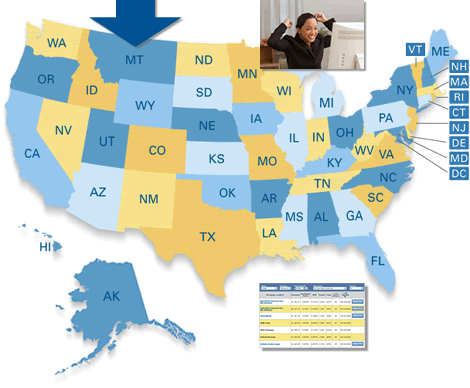Missing Your W-2? Don't Panic, Here's Your Action Plan!
It's a common cornerstone of tax season: the W-2 form. Officially known as the Wage and Tax Statement, this crucial document outlines your annual earnings, as well as the taxes withheld from your paycheck throughout the year. Completing your tax return without your W-2 can feel daunting, as every box filled on this form plays a vital part in ensuring your return is accurate and that you receive any refund owed to you. If your W-2 seems to have gone AWOL, worry not! We'll guide you through the necessary steps to reclaim your missing information and keep your tax filing process on track.
Deadlines to Request and File W-2s
If you've lost your W-2, don't panic! But it's important to act promptly and understand the key deadlines for getting a new copy and for when you need to file your taxes. Missing these deadlines can lead to unnecessary hassle and potential penalties.
Key Deadlines for Employers to Provide W-2s
Employers are required by law to send out W-2 forms to their employees by January 31 for the previous year's earnings. If this date passes and you have not received your W-2, contact your employer immediately to request a copy.
IRS Deadlines for Filing Your Tax Return with or Without a W-2
When it comes to filing your tax return, the IRS sets an annual deadline, usually on April 15. If you're unable to retrieve your W-2 in time, the IRS still expects you to file your taxes by the due date. However, you can use Form 4852, Substitute for Form W-2, if you haven't received your W-2 in time to file. In case you need more time, you can also apply for an extension, which gives you until October 15 to file your return. Remember, even if you file for an extension, you're still expected to pay any estimated taxes owed by the April deadline.
Contacting Your Employer
If you've realized that your W-2 form is missing, the first and most important step is to get in touch with your employer immediately. Don't wait—time is of the essence when it comes to tax documentation. There are a couple of ways to reach out:
- Phone Call: A phone call can be the quickest way to resolve the issue. Ask for the payroll department or the person in charge of employee taxes. Keep a record of the conversation for future reference.
- Email: An email provides a written record of your request. Make sure to ask for a read receipt or follow up if you don't get a reply within a reasonable timeframe.
Having your contact information up to date with your employer is crucial. If you've recently moved or changed your contact details, it's possible your W-2 was sent to the wrong place or you were not reachable for any clarifications. Update your current information to make sure you receive your duplicate W-2 without any further issues.
Checking the Status of a Requested W-2
Have you requested your W-2 and are wondering what's next? It's important to keep track of your W-2 request to ensure you receive it in time for tax season. Here's how to follow up effectively and determine when to seek IRS intervention.
How to Follow Up With Your Employer
If you've already requested your W-2 from your employer, wait a reasonable amount of time for it to be sent out—typically a week or two. If it hasn't arrived, take the following steps:
- Contact your employer again and confirm they have your correct mailing address or email for electronic delivery.
- Ask for a timeframe on when you can expect the W-2. Request a tracking number if it was sent by mail.
- If possible, offer to pick it up in person to expedite the process.
When to Move on to IRS Assistance if There is No Response
If your employer is unresponsive, or if the W-2 is still missing after the follow-up, it's time to branch out for additional help:
- Contact the IRS after February 15. This allows your employer adequate time to issue the form as required by law.
- Call the IRS at 1-800-829-1040 and be ready to provide your personal information, as well as your employer's details and an estimate of your earnings and withholding. The IRS will attempt to contact your employer on your behalf.
- If the regular tax deadline is approaching and you still do not have your W-2, you might need to utilize Form 4852, which serves as a substitute for Form W-2.
Meticulously tracking your requested W-2 and knowing when to escalate the matter to the IRS can help you avoid delays and penalties associated with late tax filing.
Need Help With a Missing W-2? Contact the IRS
If you've exhausted all options with your employer and the W-2 form is still missing, the IRS can offer assistance. It's important to know when and how to get the IRS involved so you can ensure your taxes are filed accurately and on time.
When Should You Contact the IRS?
If you haven't received your missing W-2 by February 15th, this is the time to reach out to the IRS for help. At this point, you've likely already requested the form from your employer and given them ample time to supply it. Now, the IRS can step in to urge your employer to provide the necessary document.
How to Reach Out to the IRS
Contacting the IRS is straightforward. You can call their toll-free number at 1-800-829-1040. When you make the call, ensure you have the following information ready:
- Your name, address, Social Security Number, and phone number.
- Your employer's name, address, and phone number.
- An estimate of your wages and federal income tax withheld in the previous year, which can be based on your final pay stub or leave-and-earnings statement, if available.
Once you've provided this information, the IRS will contact your employer and request the missing W-2 on your behalf. In the meantime, they may also issue you a Form 4852, which is a substitute for the W-2 form, allowing you to complete your tax return.
Provide Accurate Information to the IRS
When dealing with the IRS, it's crucial to provide accurate and complete information to avoid complications with your tax return. If you estimate your earnings, do so to the best of your ability and be prepared to amend your tax return if any discrepancies arise once the actual W-2 is furnished.
The IRS is your ally when it comes to resolving issues with missing W-2 forms. With the right approach and all necessary information at hand, you will be able to file your returns accurately—either with your original W-2 or through the use of Form 4852.
Lost Your W-2? Here's How to Use Form 4852 as a Substitute
If your W-2 form has gone missing, don't worry! The IRS has you covered with Form 4852, a substitute for the W-2. This form can be used if your employer does not provide your original W-2 in a timely manner or if the form they provided contains incorrect information that they do not correct. It's important to take this step seriously, as your tax return depends on the accuracy of the information you provide.
Step-by-Step Guide to Filling Out IRS Form 4852
To accurately complete Form 4852, you will need to estimate your wages and taxes withheld as closely as possible. Look at your final pay stub for the year, which should provide you with the necessary details. Here are some key pieces of information you'll need:
- Your employer's name, address, and EIN (Employer Identification Number)
- Your employment dates
- An estimate of your wages earned
- An estimate of the federal, state, and other taxes withheld
If you're unsure about any figures, it's better to overestimate than underreport. The IRS may levy penalties for under-reported income and taxes.
Note: Filling out Form 4852 requires a good faith effort to provide accurate information. If you later receive your W-2 and there are differences between it and your Form 4852, you may need to file an amended tax return using Form 1040X.
How to File With Form 4852
Attach Form 4852 to your tax return in place of the missing W-2. Make sure the information on Form 4852 mirrors the tax information you report on your tax return. Double-check that the form is signed, as an unsigned Form 4852 could result in processing delays or rejections.
By using Form 4852, you can ensure that missing or incorrect W-2s won't stop you from filing your taxes accurately and promptly. However, remember that if you do receive your W-2 after filling out Form 4852, you may need to correct your tax return if there are any discrepancies.
Estimating Income and Withholding Taxes: Navigating Your Finances Without a W-2
Lost your W-2? While your efforts to retrieve or replace it continue, it's vital to start estimating your income and withholding taxes to prepare your tax filing. This proactive approach not only aids in filing your taxes on time but also minimizes the chance of discrepancies that could lead to amending your return in the future.
Strategies to Estimate Your Earnings and Taxes Withheld
Your last pay stub of the tax year can be an invaluable resource in this scenario. It usually contains detailed information about your earnings and the amount of federal, state, and other taxes withheld throughout the year. If you don’t have access to your last pay stub, you can review your bank statements for salary deposits or reach out to your company’s payroll or HR department for a breakdown of these figures.
- Refer to your last pay stub for total earnings and tax withholdings.
- Examine bank statements for consistent salary deposit amounts.
- Contact your employer's payroll or HR department for a detailed earnings statement.
The Importance of Accuracy
Accuracy is your best defense against having to file an amended tax return. Estimated figures should be as close to the actual numbers as possible. Relying on guesswork can lead to errors in tax calculation and potential penalties. If you're unsure, it's better to seek the assistance of a tax professional who can help you make the most accurate estimations and guide you in using Form 4852, the IRS substitute for form W-2.
Remember, these steps are a temporary measure until you receive your actual W-2. Once you do, make sure to verify the estimated figures and adjust your tax return if necessary. Your attention to detail now will smooth out the road ahead for any tax-related tasks you'll face.
Filing for an Extension on Your Taxes
If you've lost your W-2 and time is ticking closer to the tax filing deadline, don't panic just yet. There is a way to give yourself a buffer—filing for a tax extension. This can grant you additional time to gather the necessary information to complete your tax return accurately.
How to File for an Extension if Your W-2 Is Lost
Missing your W-2 doesn't have to mean missing the deadline. The IRS allows taxpayers to request an automatic six-month extension to file their tax returns. To do this, you must fill out Form 4868, Application for Automatic Extension of Time To File U.S. Individual Income Tax Return, before the regular filing deadline. Submitting this form doesn't extend the time to pay any taxes owed, but it does prevent you from being penalized for filing late while you sort out your W-2 situation.
Consequences and Penalties for Late Filing Without an Extension
Ignoring the tax deadline without securing an extension can lead to significant consequences. The IRS imposes a failure-to-file penalty, which is usually 5% of the unpaid taxes for each month or part of a month that a tax return is late. Therefore, it's critical to file for an extension to avoid these unnecessary penalties while you take the necessary steps to obtain the information that’s usually reported on a W-2.
- Complete and submit Form 4868 by the tax filing deadline.
- Pay an estimate of the taxes you owe to avoid additional penalties and interest.
- Use other documentation like the final pay stub of the tax year to estimate income and taxes paid if you don't have your W-2.
Note: Even with an extension, it's important to act promptly to retrieve or replace your lost W-2.
Correcting Errors on a Received W-2
It's crucial to ensure your W-2 is accurate as it represents your earnings and tax withholdings for the year. If you've identified mistakes on your W-2, swiftly taking steps to correct them is imperative. Here's a guide on what to do if you find errors on your late-received W-2.
Steps to Take If Your W-2 Contains Errors
- Contact your employer promptly. The first step should always be to reach out to your employer. Often, they can issue a corrected W-2, known as a W-2c, without much delay.
- Review the corrections carefully. Once you receive your W-2c, ensure all the errors you identified have been fixed and that no new mistakes have been introduced.
- File your taxes accurately. Use the information from the corrected W-2 to file your taxes. If you have already filed, you may need to amend your tax return.
IRS Assistance for Incorrect W-2 Forms
If your employer doesn't respond or is unable to provide a corrected W-2, the IRS can help. Follow this process:
- Contact the IRS at 800-829-1040 after February 15th. You'll need to provide your name, address, Social Security number, phone number, and the following employer information: the employer's name, address, phone number, and your employment dates.
- The IRS will send a letter to your employer on your behalf. This may prompt your employer to issue the W-2c.
- If you don't receive the corrected W-2 in time to file your taxes, you may use Form 4852, which is a substitute for the W-2, to estimate your wages and deductions based on your final paystub of the year.
- If you receive the corrected W-2 after filing your taxes with Form 4852, and the information differs from your estimates, you'll need to file an amended tax return using Form 1040-X.
Accuracy in your tax documentation is essential. Take action promptly if you detect errors on your W-2. Your employer and the IRS are there to assist, ensuring your tax filings are precise and you stay compliant.
Safeguarding Your Social Security Number
While handling your W-2 forms, your Social Security Number (SSN) carries significant weight. It's not just a series of numbers—it's the key to your financial identity and should be handled with utmost care. Let's dive into practical steps you can take to protect your SSN, especially during tax season, and understand the risks associated if it falls into the wrong hands.
Why Your SSN Needs Protection
Your W-2 form contains your SSN, which employers are required to use for reporting your annual earnings to the IRS. This number is highly sensitive and, if acquired by identity thieves, could lead to fraudulent activities. Identity theft can result in unauthorized financial transactions and might even compromise your tax records, creating a complex web of issues to untangle. Hence, it's critical to safeguard your SSN at all costs.
How to Protect Your SSN During Tax Season
- Secure Storage: Keep your physical documents in a safe place, such as a locked file cabinet or safe.
- Safe Disposal: If you must dispose of documents containing your SSN, use a shredder to prevent reconstruction.
- Limit Disclosure: Only provide your SSN when absolutely necessary. If asked, inquire why it's needed and how it will be protected.
- Monitor Your Credit: Regularly check your credit reports to spot any unusual activities that may indicate identity theft.
- Be Cyber Secure: Ensure that any online platforms, where you might enter your SSN, use encryption and other security measures to protect your data.
- Be Vigilant: Remain alert to phishing attempts and scams, especially during tax season, as fraudsters often ramp up their efforts to capture personal information.
By taking these precautions, you can minimize the risk of your SSN being compromised and keep your financial well-being intact. Remember, protecting your personal information isn’t just about keeping your W-2 secure; it's about safeguarding your identity in all aspects of your life.
Consequences of Late Tax Filing: Avoid Penalties and Stress
If you've lost your W-2, it's crucial to understand that filing your taxes late can lead to unwanted penalties. It's important to adhere to deadlines even if you haven't received your W-2 form to avoid these extra charges. Here's what you need to know about the repercussions of not filing on time.
Understanding Late Filing Penalties
Not filing your taxes by the due date can result in accumulating penalties and interest charges. The IRS will charge you a failure-to-file penalty, which usually amounts to 5% of the unpaid taxes for each month that your tax return is late. Remember, this penalty starts accruing the day after the tax filing due date and can build up to as much as 25% of your unpaid taxes.
Interest Charges on Owed Taxes
Besides penalties, interest also accrues on the unpaid balance from the due date of the return until the date of payment in full. The interest rate is determined quarterly and is the federal short-term rate plus 3%. This means that the longer you wait, the more you will owe.
The Maximum Penalty
There is a cap on the late filing penalty. If a return is filed more than 60 days after the due date, the minimum penalty is either $435 (adjusted for inflation) or 100% of the unpaid tax, whichever is less. So, even if you can't pay your taxes on time, you should at least file your taxes or file for an extension to avoid these steep penalties.
What If You Can't Pay on Time?
- If you anticipate not being able to pay the entire amount of taxes owed by the deadline, you should still file on time and pay as much as you can. The failure-to-pay penalty is generally 0.5% of your unpaid taxes per month.
- You may make an arrangement with the IRS to pay the remaining balance in installments; this can help mitigate accumulating penalties and interest.
- In cases of a serious hardship, you can explore options like an Offer in Compromise, where the IRS agrees to settle your tax liability for less than the full amount owed.
Remember, even without your W-2, taking action before the deadline can save you money and stress. Contemplate the consequences and make an informed decision to file your taxes or an extension on time.
Ensure Timely Delivery: Keep Your Address Updated!
One common reason taxpayers may not receive their W-2 forms is due to out-of-date address information on file with their employer. It’s crucial to keep your address current to avoid any disruptions. Tax documents like the W-2 are typically sent to the last known address your employer has. If you've moved and not updated your address, you could miss these important documents, which are essential for filing your taxes accurately.
- Update your address with your employer as soon as you move.
- Notify your company’s HR department or payroll processor of any changes to your residential details.
- For future ease, consider opting for electronic delivery if your employer offers it.
Being proactive about maintaining updated personal information with your employer will help ensure that you receive your W-2 on time and can avoid any hassles when tax season arrives.
Ensuring You Receive Your Electronic W-2: Steps to Take
In today’s digital age, more employers are adopting the eco-friendly and efficient option of providing W-2 forms electronically. While this method offers quicker access to vital tax documents, it requires your consent to ensure you actually receive your electronic W-2. If you've opted for this convenience, here's what you need to do.
Consenting to Electronic Delivery
To start receiving your W-2s electronically, you must typically give your employer formal consent. This consent not only indicates your preference for electronic documents but also acknowledges your responsibility to maintain a valid email address and access the necessary documents online.
- Log into your workplace portal: Your employer should provide a secure portal or website where you can view and consent to electronic W-2 delivery.
- Find the consent form: Look for a section regarding tax documents, W-2 forms, or electronic consents. Read the terms carefully before agreeing.
- Provide your consent: Complete the process as directed, usually by checking a box or submitting a form. This action officially enables your employer to send you W-2s electronically.
- Verify your email address: Ensure that your employer has your current email address on file and check it regularly, especially around tax season.
- Check your spam folder: Sometimes, electronic W-2s may end up in your spam or junk folder, so it's a good habit to check there if you haven't received the expected document.
After consenting, remember that it is your responsibility to notify your employer if your electronic contact information changes. Keeping everything up-to-date ensures that you will always receive your W-2 form promptly, avoiding any unnecessary tax season stress.
Protecting Your Identity: Steps to Take If You Suspect W-2 Fraud
If you're concerned that your missing W-2 could be a result of identity theft or fraud, it's essential to act swiftly to secure your information and prevent further damage. Tax-related identity theft can be stressful, but there are clear actions you can take to address the situation.
Immediate Actions for Suspected W-2 Fraud
If you suspect your W-2 has been compromised, follow these steps:
- Contact the IRS: Report the issue to the IRS immediately. They can take steps to secure your tax account and provide you with guidance on what to do next.
- File a Police Report: Consider reporting the case to your local police department. A police report can serve as an official document signifying the crime, which may be required by financial institutions or credit agencies.
- Check Your Credit Reports: Monitor your credit reports from the three main credit bureaus for any suspicious activity. If you see accounts you didn't open or unexpected inquiries, this may indicate identity theft.
- Place a Fraud Alert or Credit Freeze: You have the option to place a fraud alert, which notifies potential creditors to verify identity before opening new accounts, or a credit freeze, which stops access to your credit reports completely.
Resources for Victims of Tax-Related Identity Theft
There are several resources dedicated to assisting victims of tax-related identity theft:
- IRS Identity Theft Central: The IRS provides a specialized department to assist with tax-related identity theft. They offer resources and guidance to help you regain control of your tax records.
- Identity Theft Resource Center: This nonprofit organization provides free assistance to victims of identity theft, including one-on-one victim support.
- Federal Trade Commission (FTC): The FTC has a website, identitytheft.gov, which offers detailed instructions and forms for reporting identity theft and developing a recovery plan.
Remember, staying vigilant and responding quickly are your best defenses against the damaging impacts of identity theft. If you believe your W-2 has fallen into the wrong hands, don't wait. Take action to secure your personal information immediately.
Amending Tax Returns With Correct Information
If you've filed your tax return and then discovered errors or you received your W-2 after filing, you may need to amend your tax return to correct the information. Filing an amended return is crucial for ensuring legal and financial accuracy. Here's how to go about it:
- File Form 1040X: Use the IRS Form 1040X, Amended U.S. Individual Income Tax Return, to correct income, deductions, or credits on a previously filed tax return.
- Proper Timing: You typically have three years from the date you filed your original tax return or two years from the date you paid the tax, whichever is later, to file an amended return if you're claiming a refund.
- Multiple Amendments: If you need to amend more than one tax year, you must file a separate Form 1040X for each year and mail them in separate envelopes.
- Explain Changes: Attach a detailed explanation of the changes you're making to avoid any confusion or processing delays.
- Correct Refund or Balance Due: If your amendment results in a refund, you'll receive a check once your amendment is processed. If you owe additional taxes, pay them promptly to avoid potential penalties and interest.
Remember, amending your tax returns is a sign of your commitment to financial accuracy and legal compliance. It demonstrates your intention to report your income and deductions correctly. Although it might seem daunting, rectifying errors on your tax filings is a necessary step. If you are in any doubt or need assistance, it is always wise to consult with a tax professional.
Conclusion: Taking Control When Your W-2 Goes Missing
If you've lost your W-2, it's important to stay calm and act quickly. Recapitulating the steps: initially, reach out to your employer to request a duplicate. If this approach fails, contact the IRS or consider using IRS Form 4852 as a last resort. Should deadlines approach, remember, you can request an extension to file your federal income tax return and avoid late filing penalties.
Proactivity is vital to ensure you're equipped to handle this situation. The earlier you begin the process of retrieving or replacing your W-2, the smoother your tax season can be. Keep the IRS informed throughout the process; they are there to assist taxpayers in getting the information they need for their tax return.
Remember, losing your W-2 can be stressful but doesn't signal disaster. With timely actions and the right resources, you can fulfill your obligations without letting this hiccup hinder your financial responsibilities. Knowing your wage information, and having your employment details at hand can make the process more manageable.
Other related articles:
Deposit Accounts: Types of Savings Accounts
When Shopping for a Savings Account, Don't Forget About Credit Unions
Combat the Weak Dollar With Smart Savings
Don't Let Low Rates Scare You Away fromSaving
Look Online to Kick Off Your Savings the Right Way
Save Money Using a Money Market Account
Americans Now Have More Options for Retirement Savings
Do Yourself a Huge Favor: Save 10%
Fannie Mae & Jumbo Mortgage Rates
Just One Click! = Current Rate Chart

Start by selecting your state
l

Identity Theft!
- Identity Theft: It's Big Business
- Identity theft tops consumer complaint list, 'imposter scams' debut
- Identity Theft Protection Services, Are They Worth It?
- Identity Theft on the Internet
- Protecting Seniors From Fraud
- Identity Theft
- Identity Theft Prevention
- Identity Theft on the Internet
- What to do if You're a Victim
- Identity Theft Protection Services
- Keep holiday identity theft in check
- Identity theft tops consumer complaint list, 'imposter scams' debut
- How to deploy no-cost, do-it-yourself ID theft protection
- IRS joins Justice Department in ID-theft, refund fraud crackdown
- Understanding Credit Cards: Checking Your Credit


